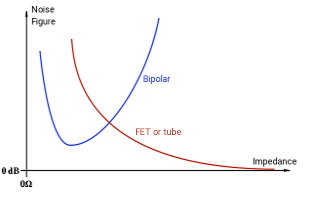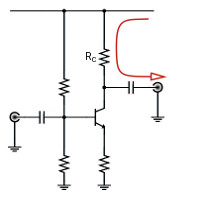Thermal Noise and Noise Figure
Detailed Wiki Page of
Thermal Noise and
Noise Figure.
The
Thermal Noise is a random voltage (or current) generated by all electric resistances, in the function of temperature. In the audio world it is rarely mentioned because usually it has low enough
level to be ignored - but not for MC head amplifiers, see the detailed computations below. Note that it must be taken into account in the case of transformars too.
The thermal noise can be calculated exactly (see
this page). For audio circuits it is recommended to calculate
15-20 kHz bandwidth. For example: a device having 40Ω internal resistance generates cca 0.1 µV (microvolt) effective noise voltage. The "device" can be anything (microphone, pick-up cartridge, transformator,
cable, etc...), if it has resistance. The amplifier can only make it worse in the further processing, so it determines the theoretical limit of the SNR (Signal to Noise Ratio).
A curiosity of physics that
every resistor, independently from its resistance, generates cca
2.6*10-16W noise power in the audio frequency range,
at room temperature. The noise voltage and current can be calculated this way too.
The
Noise Figure gives the noise degradation between two points of the signal path. It is also not (or at least rarely) used in connection with audio devices (rather in radio engineering), because it is pointless
when listening music. However, it can be useful for engineers: it shows how close to the theoretical limits we are. In this case the input comes from e.g. the cartridge (where the noise is determined by the thermal noise),
and the signal goes through the amplifier: at the output we have worse signal-to-noise ratio (SNR) than at the input. The ratio between the two SNR values is the Noise Figure.
This is more useful for music listeners: it gives the ratio between peak signal level and the noise. This is what must be optimized, the previous parameters only help this procedure.
This noise is produced by the generator (signal source) itself (see the section
thermal noise). There is nothing to do with it, but
try to keep the noise of the amplifier at a lower level to reach the possible lowest noise.
Let's see some examples:
- MC cartridge (e.g. Ortofon MC10):
Output signal voltage: 0.1mV
Internal resistance: 3Ω
The thermal noise can be calculated (see the formula here)
Thermal Noise Voltage: 28nV (nanovolt, RMS)
The Sigbnal To Noise Ratio (SNR) is the ratio of these voltages: 20log(0.1mV/28nV) = 71dB
- Generic MM cartridge:
Output signal voltage: 5mV
Internal resistance: 450Ω
Thermal Noise Voltage: 341nV (nanovolt, RMS)
The Signal To Noise Ratio: 20log(5mV/341nV) = 83dB
Note that it is the
noise of the signal source, so it can only be worse at the output of any amplifier (or transformer).
This noise is caused by the resistance of the internal base connection. Because it is usually not mentioned in the documentations, it is hard to find
proper types. In general, if it is missing from the doc, that transistor is not suitable for MC head amplifiers. If it is given (called r
bb', or
Bulk Resistance), then it must be smaller than the generator resistance - or else it would increase the noise.
For MAT02 it is 0.5Ω, which is small enough, even for extremely low impedances. Some other suggestions are: 2SD786, 2SB737, MAT12, MAT14, SSM2212
We can also select some preamplifier transistors with
extremely high transition frequency because these types usually must have low enough
r
bb', even if it is missing from their documentation. These can be significantly cheaper and easier
to find. However, the high frequency (probably in GHz range) means an important problem: the circuit must be designed as a microwave amplifier - even if
it operates only in audio frequency range, or else it will oscillate. I tried
BFW16A
first and worked for my MC10 cartridge well enough. However, it has low current amplification factor, so probably cannot be used for higher impedances. Later I
tried BFP193 and BFU768: these are better (even for higher impedances - e.g. 40Ω), but hard to prevent the oscillation (8GHz and 37GHz F
T). At least, if it succeeds, we get low noise and low distortion, superb sound.
Másik kiválasztási szempont lehet, hogy
extrém magas határfrekvenciájú, kiszajú előerősítő tranzisztort keresünk - lehet hogy ilyent könnyebb
beszerezni, és biztosan olcsóbb is. Az első amit kipróbáltam, az a BFW16A típus volt. Sajnos az adatlapja szűkszavú, de elsőre jó volt. Az áramerősítési
tényezője elég alacsony, ezért inkább extrém kicsi impedanciákra jó (pl. Ortofon MC10-hez). Mostanában próbálkoztam BFP193 és BFU768 típusokkal, ezek már
egészen kiválóak. Persze, a nagy határfrekvencia átok is egyben: az áramkört mikrohullámú szempontok szerint kell tervezni, hiába csak hangfrekvenciás.
According to my attempts, the MAT02 or SSM2212 are the best. Easy to build (no microwave oscillation), low noise, good quality sound.
To build MM or MI preamplifier, this kind of noise probably can be ignored.






